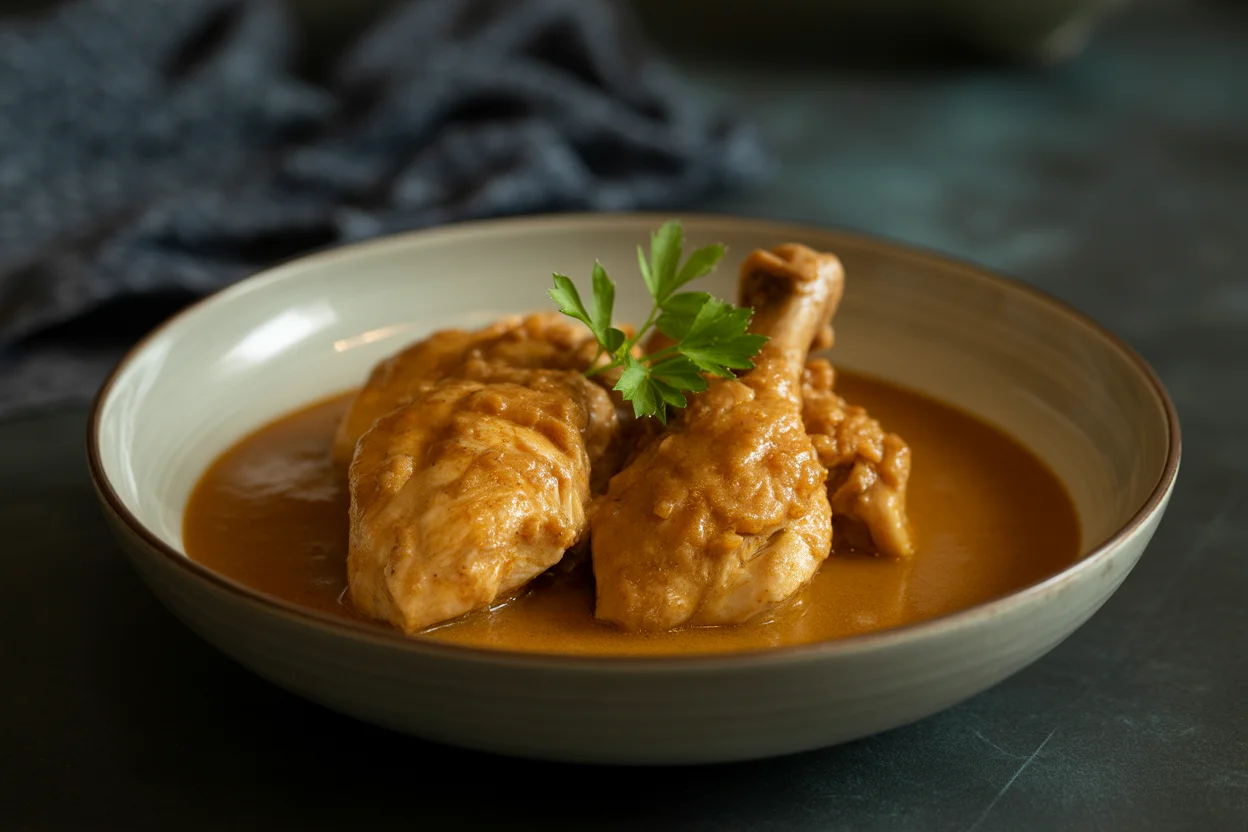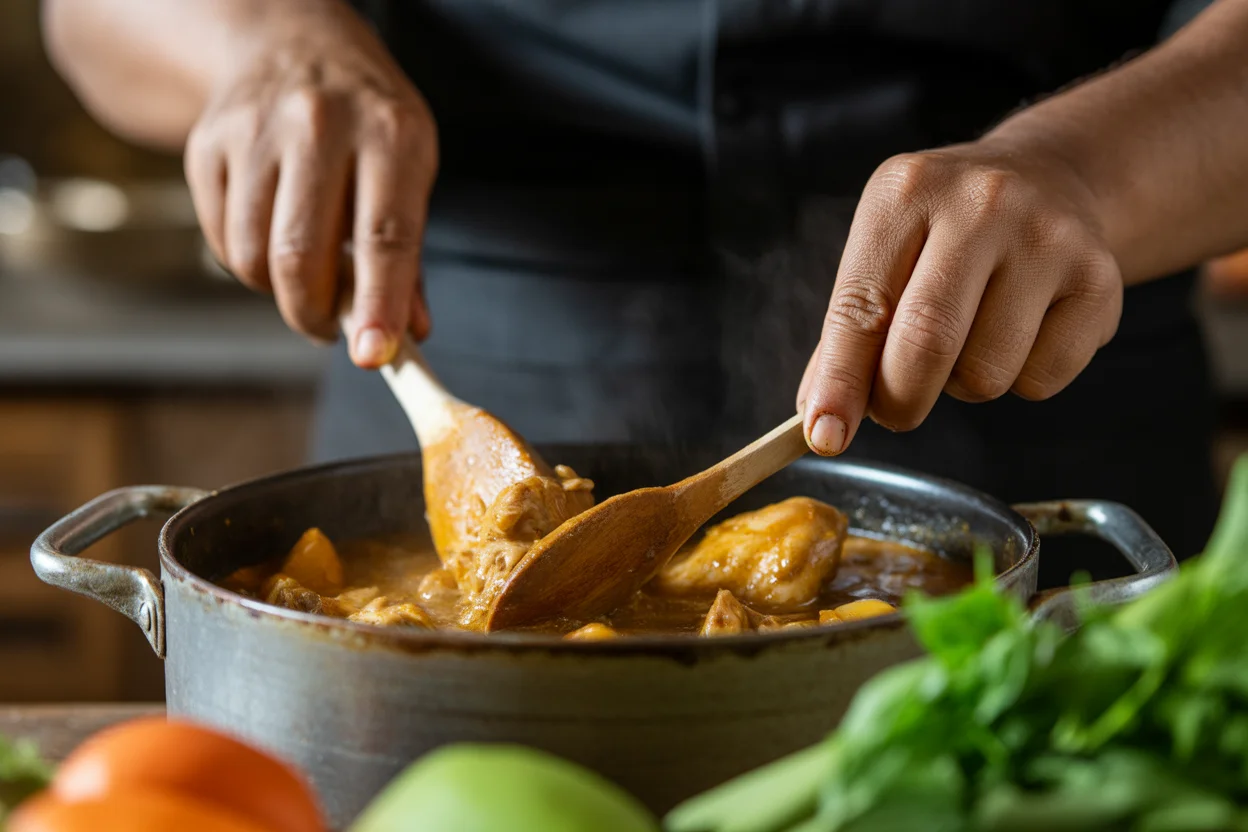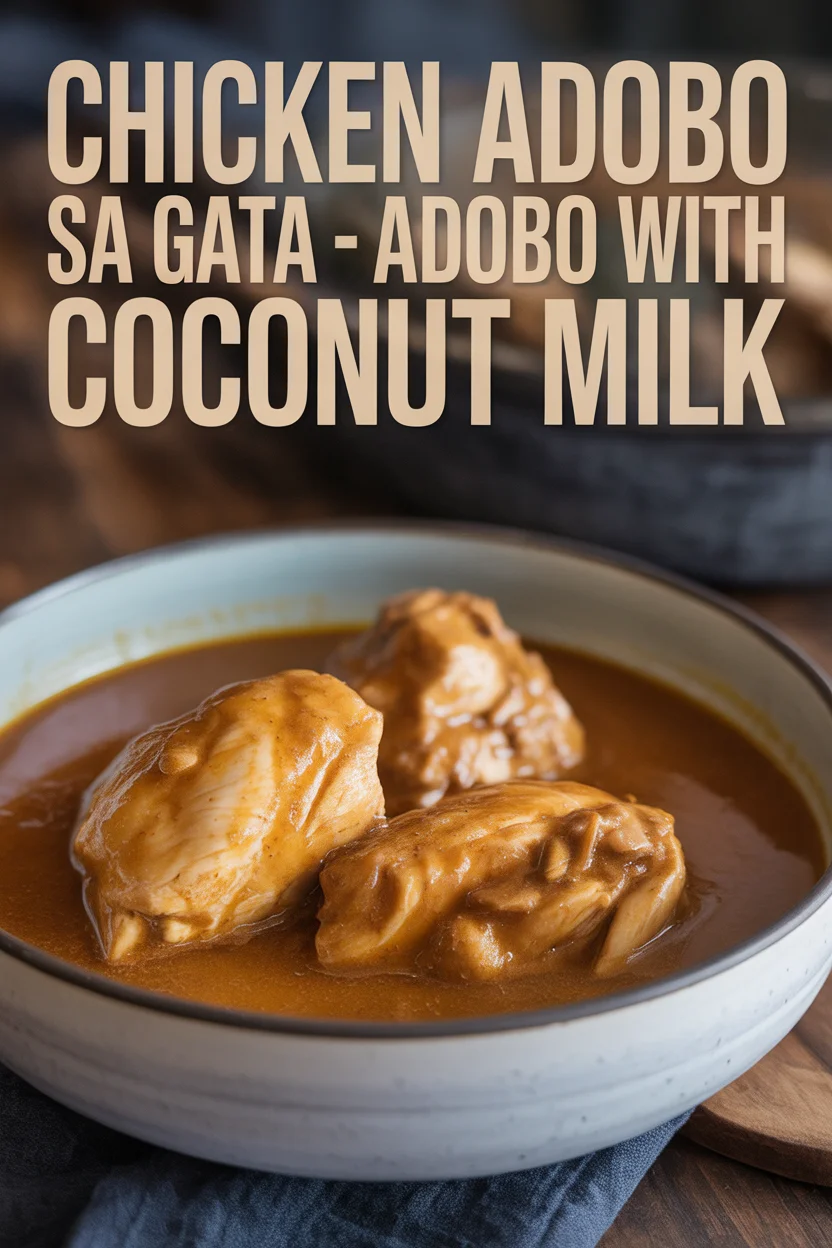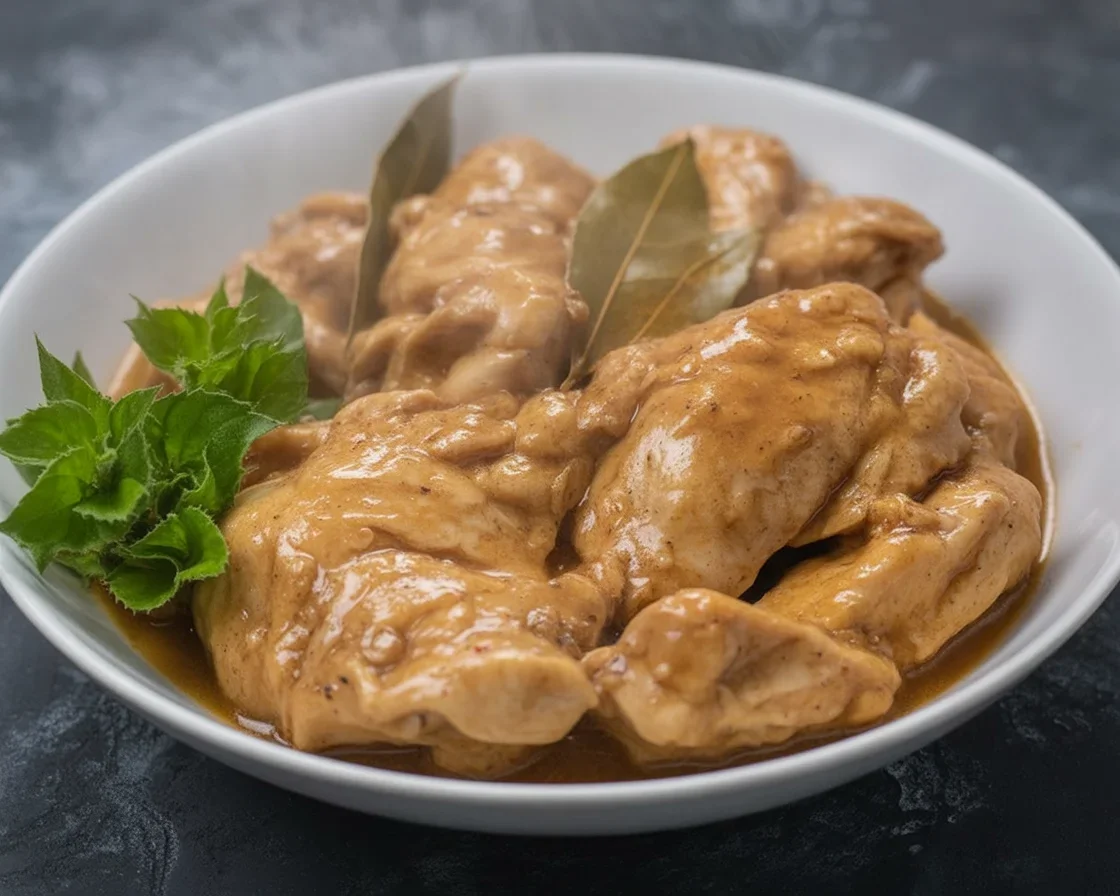Filipino chicken adobo sa gata always comes to mind when I’m craving something comforting but don’t want to eat the same dish twice in a row. Maybe you’ve tried regular adobo (who hasn’t, right?) but found it a bit tangy or just missing that wow factor. Well, listen, when you pour coconut milk into the mix—I’m telling you, everything changes. That subtle sweetness, creamy sauce, plus all those layers of flavor. Even picky eaters in my house end up asking for seconds. Here’s honestly the best thing: it smells incredible, tastes amazing, and it’s simple, too. Oh, and if you wanna dive into more options, check out this chicken adobo sa gata creamy coconut milk twist for a fresh spin or peek at this coconut adobo adobo sa gata recipe US if you’re cooking abroad. 
Introduction to adobo sa gata
Alright, so adobo itself gets a big spotlight in Filipino cooking. Almost every household has their own way, and yes, every Tita claims hers is the best—sometimes it’s true, sometimes you nod politely. But chicken adobo sa gata is a creamy, coconutty twist that takes the classic up a notch. Not gonna lie: the first time I smelled adobo bubbling on the stove with coconut milk, I kinda wondered if this was legal. The aroma? Ridiculously good.
Let’s get this out of the way. “Sa gata” just means “with coconut milk” in Filipino. You’re basically upgrading an already tasty chicken adobo by making it velvety and rich. Suddenly, a regular dish turns into this five-star restaurant kinda thing—except you don’t need fancy ingredients or a chef’s hat. Nope, just your regular pot and a giant spoon (preferably wooden, because grandma insists that’s how it’s done).
A pro tip: don’t skimp on the coconut milk. I once tried light coconut milk to “save calories,” and trust me, Auntie was not happy. Go full-fat for full flavor. 
Preparing chicken
So, which chicken pieces are best for chicken adobo sa gata? Personally, thighs and drumsticks are the go-to. Bone-in gives all the flavor. But, if you’re working with breast (because that’s what was on sale), that works too—just be gentle so it doesn’t dry out.
I like to give my chicken a quick rinse (I know some people skip this, but old habits stick). Pat it dry, sprinkle a bit of salt and pepper, then let it air for a sec. Some folks marinate in soy sauce and vinegar overnight for ultra flavor-packed meat. Honestly, sometimes I forget to marinate and it still tastes great. Life’s busy, right?
My friend once said tossing garlic, onions, and bay leaves directly on the uncooked chicken “unlocks all the flavors.” Not totally sure about the science, but, eh, it works for me. You’re building layers of flavor from the start.
“Tried it with just thighs and extra garlic. My kids cleaned their plates and asked for more sauce—score!” – Lila Reyes, Batangas

Cooking coconut sauce
On to the fun part! Once your chicken’s had its moment, toss it into a big old pot (or a deep pan, whatever’s roomy). Toss in sliced garlic, chopped onions, a couple of peppercorns, and bay leaves. Add soy sauce and vinegar—don’t stir after adding vinegar! Seriously, just let it sit there bubbling for a bit so that tangy punch doesn’t go overboard.
Now, pour in that luscious coconut milk. Watch the sauce transform from clear and deep brown to this creamy dream. Some folks like to add the coconut milk at the tail end so it doesn’t split, but I dump it in right after the sauce starts simmering. If you stir it gently, it’ll be okay.
Let it simmer low and slow until your chicken’s pretty much falling apart—or, y’know, just fork-tender enough for your taste. The sauce? Keep an eye on it. Give it a stir so nothing sticks because burnt coconut is not the vibe. If it gets too thick, splash a bit of water in.
Don’t rush! A little patience goes a long way. Some days, the aroma wafting out of the kitchen is enough to make the neighbors text, “What’s cooking?”
Adding spices
Chicken adobo sa gata is all about that perfect balance, but also… get creative! For me, black peppercorns are a must, and extra garlic never hurts. Ground pepper? Sure, if you want a little more kick. Chili if you like it spicy—bird’s eye chili (siling labuyo) will make everyone sweat, but it’s a thrill.
I sometimes sneak in a dash of brown sugar. Don’t tell my mom. It cuts through the vinegar and brings out extra creaminess in the coconut sauce. You can jazz it up with ginger, too, for a bit of zing. Just don’t overpower things. Oh, and if you’re not wild about tang, lessen the vinegar a smidge.
By the end, all those spices kind of meld together—sweet, salty, tangy, spicy. That’s the jackpot. I’m cautious with salt, though, because the soy sauce is already salty. Give it a taste before you dump more in. Trust me, start slow. You can always add, but you can’t take it out (been there, regretted that).
Serving
This dish shines with simple sides. Here are a few ideas to nail it:
- Pile over steamed white rice (extra sauce, please!)
- Sprinkle with toasted garlic for a little crunch
- Pair with atchara (pickled papaya) if you want some zing
I mean… sometimes I scoop it right from the pot and skip the formalities. Life’s short.
Flavor notes
The first spoonful? Oooh, that’s magic. Chicken adobo sa gata tastes creamy and mellow, but also slightly tangy from the vinegar. Coconut milk wraps everything in silkiness, with garlic and bay leaf making it savory. It doesn’t punch you in the face; it’s gentler, but still rich, so you’ll want to wipe your plate clean.
If you grew up eating regular adobo, you’re in for a surprise. The coconut makes it taste familiar and new at the same time. That’s honestly wild. Also, leftovers—if any—get even better the next day. Something in the fridge-overnight magic, I guess.
If you love adobo spins, you have gotta snoop around these creative twists at 10 adobo variations Filipino adobo variations or peek at the savory tang in adobong pusit squid adobo with vinegar and soy sauce. Filipinos just keep reimagining adobo, and I’m here for it.
Tips
Honestly, the best chicken adobo sa gata needs just a bit of patience and solid coconut milk. Here’s what I’ve learned:
- If you want deeper color—use a bit more soy sauce!
- Use a heavy-bottomed pot so the coconut sauce doesn’t stick (trust me, it burns fast on thin pans).
- Taste as you go. Don’t be afraid to tweak, especially the vinegar-salt balance.
Keep a window open if you don’t want your living room smelling like a tropical paradise (unless you do, and who wouldn’t?).
Common Questions
Q: Will boneless chicken work?
A: Yes, but flavor’s a little less robust. Throw in more garlic and simmer gently.
Q: Can I add veggies?
A: Sure thing! Eggplant or spinach works. Just toss them in during the last 10 minutes.
Q: Can I use light coconut milk?
A: Technically, yes, but the sauce won’t be as creamy. Go full-fat for full comfort.
Q: What if my sauce splits?
A: No panic. Pull it off the heat fast. Stir in a tablespoon of cold coconut milk and it’ll smooth out.
Q: Does it freeze well?
A: You bet. Stash it in a freezer-safe box, thaw fully before reheating.
Why This Dish Is Always Worth It
Okay, to wrap it up: chicken adobo sa gata is one of those feel-good meals that says comfort in a bowl. The coconut milk magic is real, you guys—transforming a humble chicken into something lush, crave-worthy, and extra satisfying. You get that classic adobo tang, but mellowed out and creamy, with just the right amount of spice if you want. Wanna master more Filipino favorites? I say try the Adobong Manok sa Gata – Panlasang Pinoy or the elegant spin in Filipino Chicken Adobo with Coconut Milk (Adobo sa Gata) for a different perspective. C’mon—grab that pot, pour in the coconut milk, and treat yourself to a proper home-cooked hug.

Chicken Adobo sa Gata
Ingredients
For the Adobo
- 4 pieces Chicken thighs or drumsticks Bone-in for extra flavor
- 1 tablespoon Salt To taste
- 1 teaspoon Pepper To taste
- 3 tablespoons Soy sauce For marinating
- 0.5 cup Vinegar Do not stir after adding
- 1 can Coconut milk Use full-fat for best flavor
Aromatics and Spices
- 5 cloves Garlic, sliced Adds depth of flavor
- 1 medium Onion, chopped
- 2 pieces Bay leaves For aroma and flavor
- 1 tablespoon Black peppercorns To taste, or adjust as preferred
- 1 teaspoon Brown sugar Optional, to balance acidity
Instructions
Preparation
- Rinse the chicken and pat it dry. Sprinkle with salt and pepper and let it air dry.
- Marinate the chicken with soy sauce and vinegar for at least 15 minutes or overnight for best flavor.
Cooking
- In a large pot, place the marinated chicken and add sliced garlic, chopped onions, bay leaves, and peppercorns.
- Pour in the coconut milk without stirring and let it simmer.
- Simmer low and slow until chicken is fork-tender, adjusting heat as necessary to avoid burning the sauce.
- Add additional water if the sauce thickens too much.
Final Adjustments
- Taste the sauce and adjust the seasoning with additional salt, vinegar, or spices as desired.
Serving
- Serve over steamed white rice, and sprinkle with toasted garlic if desired.
- Optionally, pair with atchara (pickled papaya) for extra zing.

